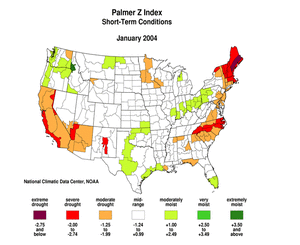U.S. Drought Highlights:
- On the national scale, severe to extreme drought affected about 18 percent of the contiguous United States as of the end of January 2004
- moderate to extreme drought affected about 28 percent of the contiguous U.S.
- January was drier than normal across a significant portion of the western and Great Plains drought areas
- The month was also dry from New England down much of the eastern seaboard
- January marked the fourth consecutive month with below-normal precipitation regionwide across the Southeast, where November 2003-January 2004 precipitation averaged less than 50 percent of normal in places
- Long-term moisture deficits (last 6 to 24 months) persisted across parts of the Upper Midwest to southern Plains, and most of the West
Please Note: The data presented in this drought report are preliminary. Ranks, anomalies, and percent areas may change as more complete data are received and processed.
National Overview
On the national scale,
- severe to extreme drought affected about 18 percent of the contiguous United States as of the end of January 2004, an increase of about 1 percent compared to last month
- about 28 percent of the contiguous U.S. fell in the moderate to extreme drought categories (based on the Palmer Drought Index) at the end of January
- on a broad scale, the last two decades were characterized by unusual wetness with short periods of extensive droughts, whereas the 1930s and 1950s were characterized by prolonged periods of extensive droughts with little wetness
- about 9 percent of the contiguous U.S. fell in the severely to extremely wet categories at the end of January
- a file containing the national monthly percent area severely dry and wet from 1900 to present is available
- historical temperature, precipitation, and Palmer drought data from 1895 to present for climate divisions, states, and regions in the contiguous U.S. are available at the Climate Division: Temperature-Precipitation-Drought Data page in files having names that start with "drd964x" and ending with "txt" (without the quotes).
Regional Overview
January was drier than normal across a significant portion of the western and Great Plains drought areas. The month was also dry from New England down much of the eastern seaboard. The primary stations in Alaska were predominantly dry, while those in Hawaii were predominantly wetter than normal. The rainfall pattern in Puerto Rico was mixed during the last 4 weeks to 8 weeks, with generally drier than normal conditions in the north and east.
January marked the fourth consecutive month with below-normal precipitation regionwide across the Southeast, where November 2003-January 2004 precipitation averaged less than 50 percent of normal in places and depleted soil moisture was indicated. This is in sharp contrast to the unusually wet conditions of the previous eight months. The unusual January dryness in the Northeast contrasts markedly with extreme wetness in 2003.
In spite of the November-December wetness, long-term moisture deficits (last 9 to 24 to 60 months) persisted across most of the West. Much of the Great Plains has suffered from moisture deficits in the 6-month time frame, while parts of the Plains and Upper Midwest have had significant moisture deficits back 12 to 24 months. In the central Plains, significant deficits even show up at 60 months.
Some regional highlights:
- Winter storms earlier in the season brought an average to above-average snowpack and water year-to-date precipitation to much of the West, especially the coastal states. Snowfall relative to normal diminished somewhat during January compared to earlier months in the season, but above-average seasonal snowfall was evident in many reports from both valley stations and high altitude SNOTEL stations. However, due to the effects of the long-term drought, soil moisture conditions remained dry in many areas and the reservoirs in most of the western states were still low or depleted.
- The percent area of the western U.S. (Rockies westward) experiencing moderate to extreme drought (as defined by the Palmer Drought Index) decreased during January to about 56%. While this is not near record historical levels, it is still comparable to the major droughts of the 20th Century.
 NOAA's National Centers for Environmental Information
NOAA's National Centers for Environmental Information
